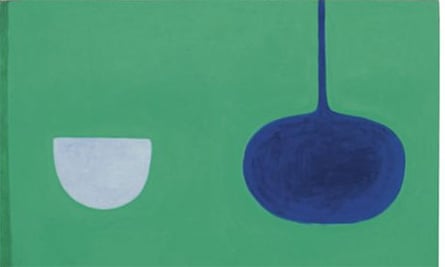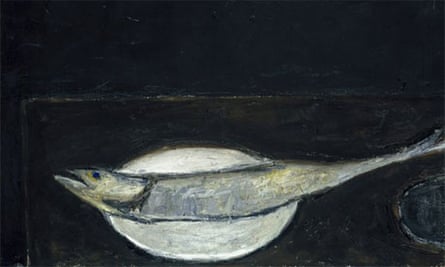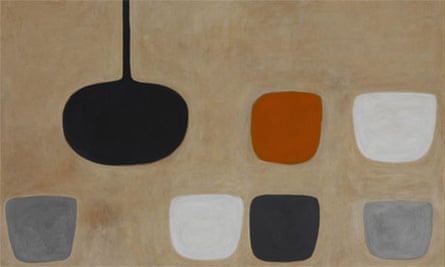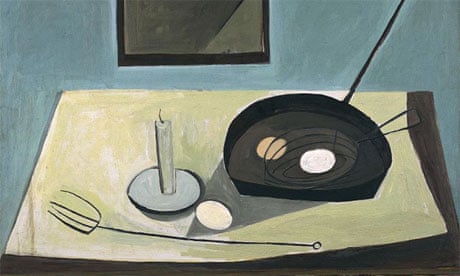In the late 1940s, William Scott (1913-1989) realised that "if the guitar was to Braque his Madonna, the frying pan could be my guitar." Described by the distinguished critic Hilton Kramer as "the best painter of his generation in England", Scott is most often admired for his kitchen-table still lifes, featuring pots, pans, bowls, plates of mackerel, pears and so on – all rendered simple and plain. "I chose … objects without any glamour," he said ("a few eggs, a toasting fork"): "I wanted my pictures to have a painting not literary success."
As is evident from the retrospective currently at Tate St Ives, Scott painted exceptional nudes and landscapes, but the "pots and pans" remain his trademark: the subject of his pictures towards the end of the second world war, they were still there in his more minimalist work of the 1970s. Yet though he said he wanted to look "through the eyes of Chardin", Scott's still lifes are far from naturalistic. All his pictures, whatever their subject, dissolve the distinction between the abstract and the figurative, so that bowls on a bare table top are actually "about" the relationship between flat forms on large areas of colour – think Rothko rather than Morandi. There is a tension and a lyricism about them, and they are immensely pleasurable and satisfying to look at.
In the 1950s, Scott was known as a pioneer of abstraction in Britain and exhibited alongside Ben Nicholson, Terry Frost, Victor Pasmore and Patrick Heron. In the British art world, abstraction was still viewed with suspicion; outside that world, it had a highly specialised appeal. In 1962, Prince Philip, gaffe-prone then as ever, almost inevitably said of one of Scott's canvases: "Are you sure it's the right way up?" (There was a fuss in the papers.)
Scott insisted he was an abstract painter in the way he felt Chardin was too: the pans and fruit were uninteresting in themselves; they were merely "the means of making a picture", which was a study in space, form and colour. So basic were the shapes he chose that they were never merely pans and crockery: serried bowls on a table could suggest rocks stacked in a dry stone wall or boats taking refuge in a harbour. And then there is the erotic element, Scott's hint that "behind the facade of pots and pans there is sometimes another image … a private one … sensed rather than seen". If the pans and pears did have an erotic feeling, he said, it was "probably due to my love for the primitive and for the elemental". The frying pan comprises, in essence, a circle and a line, and dozens of critics have discussed the intimate relations between his objects, and the sexual element to his work.

They are paintings to be treasured, and yet, in William Scott, published by the Tate to accompany the St Ives show, Sarah Whitfield writes that "if ever an artist's reputation was in urgent need of rescuing it is Scott's". The 1950s were his breakthrough decade, and in 1961 David Sylvester noted that he had acquired "the soundest, all-roundest international reputation of any living British painter, Nicholson apart". But even by the time he was given a major retrospective by the Tate in 1972, he had begun to fall out of favour. The ironies of pop art quickly made him old-fashioned. As one commentator noted, Scott had suffered "neglect … since the inception of the pop-cult and the subsequent post-McLuhan hysteria which has led to the packaging of any kind of Americana as the only stuff worth having". When the Royal Academy organised its 1987 exhibition, British Art in the 20th Century, he was left out altogether.
His stock has been low for decades, but there have been recent signs that Scott's circle of admirers is widening, not least in the auction houses: along with other 20th-century British masterpieces his works have risen sharply in price – they can now fetch £500k or more. And by the end of 2013, his centenary year, he can't help but be better known. Much Scott activity is planned: the Tate exhibition is touring and evolving after St Ives; another show will open next month at the Jerwood, Hastings; and a vast catalogue raisonné, edited by Whitfield, is due from Thames & Hudson. Scott has never been obscure exactly, but reputation rescue is nevertheless under way.
He was born in Scotland, and brought up in Enniskillen, Northern Ireland, the son of a sign-painter and one of 11 children. He later remembered this environment as a "very austere one with a philosophy of life, a rigid Protestantism, from which one cannot escape easily". The idea of austerity stayed with him: "I find beauty in plainness," he said, "in a conception that is precise." When Scott's father died trying to help firefighters get people out of a blazing house, Fermanagh Council got together money to send him, aged 15, to Belfast College of Art, and he went from there to the Royal Academy. He was a successful student and lived an impecunious bohemian life in Chelsea, sharing houses with other painters and with Dylan Thomas, who never had a room of his own, just slept on the floor using his trousers as a pillow.
Scott was drawn to the early Italians and to the primitive realism of the Cornish painters Christopher Wood and Alfred Wallis – he had a lifelong interest in childlike art, "the beauty of the thing being badly done". But the painting he most fervently admired was French – he was said to be "spellbound" at his first glimpse of a Matisse still life. When in the mid- 1930s he went to Mousehole, the Cornish fishing village, to pursue primitive realism, it was because "I could see in it Rousseau, Modigliani, Bonnard and Matisse – these painters had more meaning for me than the whimsy of Paul Klee" (Dylan Thomas liked Klee).

In 1937 Scott married Mary Lucas, a fellow student at the Royal Academy, and they set off for the continent, where the living was cheap. They settled in Pont-Aven in Brittany, a town with a connection to Gauguin, and began a summer art school. In the figurative 1938 Girl at the Table, part of the Tate St Ives show, a flattened figure (clearly Mary) sits at a table, which has on it a bowl of fruit and a bottle: as with so much of his work, a few simple objects sit within a large area of colour. Scott himself said that the picture shows the profound influence on him of French art, in particular Cézanne. Girl and Blue Table, not in the exhibition but also from this time, reveals an equal debt to Bonnard. He was "madly Francophile".
In 1941 Scott moved from wartime London to north Somerset, and began teaching at Bath School of Art; he had his first one-man show in London the following year. He liked Somerset because it was "less cleaned-up" than the home counties: as Whitfield writes, he had a hatred for "English gentility … 'snug cottages with roses around the door'". If there is a political aspect to his domestic but never homely art, it's in his rejection of anything fancy, and his embrace of ordinary utensils. Tate St Ives has The Frying Pan from 1946, which he described as a real advance. A black pan, a bowl and a toasting fork sit on a folded white cloth on a dark grey table; the background is a warm brown. His objects "were the symbols of the life I knew best … Everyone had a frying pan." Scott used his own "very black" pan only for frying fish – in Enniskillen, locally caught fish had been the staple diet.
By the time of his 1948 one-man show at the Leicester Galleries in London, Scott stood apart from two influential movements in the British art scene – the neo-Romanticism of Graham Sutherland and the "rather drab and provincial" Euston Road school. He had, so the Spectator reported, "made a name for himself". Wyndham Lewis's review in the Listener is worth quoting: "He is a newcomer. What he has to offer is an original idea of colour; a very personal, flat, empty design, as if cut out in cardboard … His statement is always so strict, parsimonious, and dogmatically severe, that it looks even emptier than it is. He brings us his mackerel, and his marigolds, as a child just able to walk solemnly brings objects … a birdcage, or a colander … and deposits them as an offering before the attentive adult."
Scott liked to associate himself with the St Ives school: spending summers in Cornwall, he met Frost and Peter Lanyon, both of whom were to teach with him at the renamed Bath Academy, housed at Corsham. These painters introduced him to Nicholson, Heron and Roger Hilton, and excitement and ideas travelled back and forth between Corsham and St Ives. There is a joyfulness about the plums, garlic, pears, grapes and lemons as well as eggs and mackerel which appear on his kitchen tables of these years (an example at the Tate is Still Life with Candlestick, 1949-50); the predominant colours of which are muted light blues, yellows and greys. The critic John Russell has written of "the real and legitimate pleasure" the artist gave "by his nimble and affectionate handling of recognisable objects".

But Scott's painting never stayed the same for long, and Nicholson pushed him further towards abstraction. The table-top was always his landscape, but when he lifted it into the vertical picture plane (so it was just a rectangle of colour), it took out a figurative component of his painting. Table Still Life from 1951 has more obviously as its subject the division of spaces, with the long, thin table legs and the spindly handles of the pans doing the dividing. In The Harbour from 1952, which Heron praised for its "animal vigour", a curved black line cuts up through whiteness – a jetty, but also perhaps a tongue or the shadow between two legs.
Scott's work is a story of different influences – French, British, American – and their absorption into a body of work which evolved, yet remained distinctive. Dubuffet has some bearing on Seated Woman (1954) at the Tate show, but Scott's next really important discovery was of the New York School, at that time almost unknown in Britain. In 1953, he visited the US and met Rothko, Jackson Pollock, Willem de Kooning and Franz Kline. He summed up his response: "By 1953 my pictures appeared to have reached a stage of total abstraction and I was one of that very small band of British abstract artists much ridiculed by our critics ... American art had not yet crossed the Atlantic … The experience was a surprise and a shock. I realised that the Americans had made a major discovery … putting abstract painting on its right scale. It was not the originality of the work … but I was overwhelmed by its audacity."

So Scott's pictures got bigger, but at the same time he reacted against what he had seen in New York, and became surer than ever of his European heritage. "There's a whole tradition, from Chardin through Cézanne to Braque and Bonnard, which has no part" in American painting, he said, "and that's the tradition I've held to". Instead of going further down the road of abstraction, he decided to return to "recognisable imagery". The pots, briefly absent, came back on the scene. Yet his pictures did also get bolder – both in their use of paint, which became thicker and more textured, and in their distortion of forms.
These were still lifes as never seen before. A trip to the Palaeolithic cave paintings at Lascaux in 1955 also rejuvenated Scott's feeling for the primitive. Ochre Still Life at Tate St Ives, in which a row of pots hugs the horizon line and the left-hand edge of the painting, is evidence of what he called a "careful-careless way of painting … I like primitive art and children's art and the things that children scratch on walls and draw on pavements". What Norbert Lynton called "painterly lavishness" took over Scott's work. In the reviews of the 1972 Tate retrospective, Whitfield writes, critics were unanimous in their praise of these sumptuously painted canvases of the late 1950s.
They were less enamoured of his abstract experiments in the 1960s, in many of which unidentified shapes float in colour fields, and of the calmer, more minimalist work of the early 1970s. These late paintings were deemed too perfect, not "badly done" enough, perhaps, and unchallenging: there was in them a marked absence of painterly lavishness. But it is arguable that rather than showing a loss of vitality, they signal another of Scott's renewals. The new and hugely impressive four-volume catalogue raisonné will do much to fill out our understanding of these later pictures. But a work such as the 1970 Still Life with Orange Note, in which his favourite thin-handled black circle appears yet again, draws you into its big spaces, and becomes another, more contemplative study in colour and simple forms. It also offers a memento of, and a comment on, the more instantly lovable work finished decades before – of the rich and longstanding relationship of a master of still life with kitchen pots and pans.

Comments (…)
Sign in or create your Guardian account to join the discussion